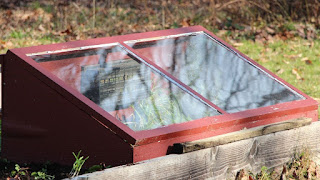 Join Windsor/ Essex County Community Garden Collective Coordinator Steve Green (@urbnfrmrgreen) as he walks us through what we as gardeners can do to make our gardens productive through winter.
Join Windsor/ Essex County Community Garden Collective Coordinator Steve Green (@urbnfrmrgreen) as he walks us through what we as gardeners can do to make our gardens productive through winter.Wednesday, Nov. 2
Windsor Public Library
Central Branch
Steve shared a recent blog post of his that features some notes from this workshop:
 Believe it or not, this is November 1st in Windsor Ontario Canada. It was an unseasonably warm 25C today. We've had a few very cold days and maybe a bit of frost here and there, but over all, the Southwestern Ontario tip experiences quite a few of these very warm days.
Believe it or not, this is November 1st in Windsor Ontario Canada. It was an unseasonably warm 25C today. We've had a few very cold days and maybe a bit of frost here and there, but over all, the Southwestern Ontario tip experiences quite a few of these very warm days.In my garden outside today I harvested peppers, parsley, tomatoes, Cape Gooseberries (like a ground cherry), and a few other things. I still have some tomatoes growing, carrots, among other finds.
Days like these are made for our greens and lettuces, our broccoli and kale, Brussels sprouts, lots of perennial herbs, and so much more. (See above list)
As they say in Game of Thrones, "Winter Is Coming!" and the warm weather won't last long. Soon the frost will be every night and the snows will come.
Don't let this be the end of your outdoor gardening! There are lots of ways to keep up the good work.

 Here's an example of how this gardener had got things ready for winter. Some of the stuff they have already used a low hoop with 4 mm plastic, other stuff is still OK even with a bit of frost. The important part is you can see they have prepared.
Here's an example of how this gardener had got things ready for winter. Some of the stuff they have already used a low hoop with 4 mm plastic, other stuff is still OK even with a bit of frost. The important part is you can see they have prepared. Here's a larger garden all set up with the hoop house frames. I have used these types of frames and I have one complaint about them: THEY RUST REALLY QUICK! Just a few seasons and ours were trashed. That's why I prefer a coated or stainless option, a 4 x 8 ft. sheet of steel fencing (like hog fencing) with small squares that will never rust through or break, OR the PVC plastic tubing (it's great- just don't work with it when it's super cold out or you will snap it). The plastic conduit PVC tubing stuff is dirt cheap too (which I really like).
Here's a larger garden all set up with the hoop house frames. I have used these types of frames and I have one complaint about them: THEY RUST REALLY QUICK! Just a few seasons and ours were trashed. That's why I prefer a coated or stainless option, a 4 x 8 ft. sheet of steel fencing (like hog fencing) with small squares that will never rust through or break, OR the PVC plastic tubing (it's great- just don't work with it when it's super cold out or you will snap it). The plastic conduit PVC tubing stuff is dirt cheap too (which I really like). Most of the time I use old windows for raised cold frames like the ones below which is great re-purposing for our garden projects.
Most of the time I use old windows for raised cold frames like the ones below which is great re-purposing for our garden projects.

 Even in the dead of winter when you think nothing is growing, your spinach will slowly grow. Here's a great example from the East Coast. Down in Windsor we have no problem growing greens right through the winter. The kale and many brassicas don't seem to mind our mild winters at all.
Even in the dead of winter when you think nothing is growing, your spinach will slowly grow. Here's a great example from the East Coast. Down in Windsor we have no problem growing greens right through the winter. The kale and many brassicas don't seem to mind our mild winters at all.

Plants that can overwinter for early spring harvest:
- alliacea (garlic, leeks, onions)
- herbs (thyme, oregano, sage, chives)
- root vegetables (turnips, carrots, parsnips)
- greens (spinach, kale)
Plants for late-fall/winter harvest:
- brassicas (broccoli, rapini, Brussels sprouts, cabbages, kohl rabi)
- root vegetables (turnips, rutabaga, carrots, beets, radishes, parsnips, Jerusalem artichokes)
- greens (kale, bok choy, collards, swiss chard, spinach, arugula)
Growing tips
- Pick varieties that grow to maturity in short time periods.
- Water less in the late fall to prevent freeze/thaw cycles from splitting vegetables.
- Plant greens, lettuces and herbs every few weeks to ensure continuous harvest throughout the season, including late into fall.
During the Q & A at the end of the workshop, Steve answered some questions about preparing strawberry plants for the winter. This page expounds upon those points.
